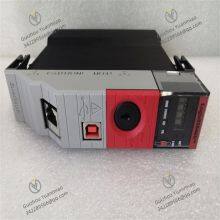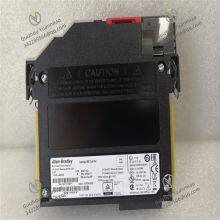I. Overview
1756-L84ES is a high-end Programmable Automation Controller (PAC) in Rockwell Automation's ControlLogix series, specially designed for large-scale and highly complex industrial automation control scenarios. On the basis of inheriting the high reliability and strong integration capability of the ControlLogix series, it further enhances processor performance, data processing capability, and network communication functions, and can easily meet the needs of large-scale equipment collaborative control, high-speed data interaction, and complex algorithm operations.
As the core of the industrial automation system, 1756-L84ES is suitable for fields with extremely high requirements on control accuracy, real-time performance, and scalability, such as large automobile assembly lines, comprehensive chemical parks, and intelligent metallurgical plants, providing strong control center support for intelligent manufacturing in the Industry 4.0 era.

II. Technical Parameters
Processor performance: Equipped with a new generation of high-performance multi-core processor, the computing speed reaches an extremely high level of K instructions per second (KIPS) (specific values are subject to the product manual). It supports multi-task parallel processing and can run various complex programs such as logic control, motion control, and process control at the same time, ensuring real-time and precise control of large-scale industrial processes.
Memory configuration: Equipped with ultra-large capacity memory, the program memory can reach hundreds of megabytes, which can accommodate massive user programs and complex algorithms; the data memory is also correspondingly improved, which can store and process a large amount of process data, intermediate variables, and equipment status information in real-time, providing sufficient space for high-speed data interaction and local data analysis.
Power supply requirements: It needs to be matched with 1756 series high-performance power modules. The input voltage supports 120V AC/240V AC industrial standard voltage, and the output is stable 5V DC and 24V DC, which can provide sufficient and stable power for the controller and the connected high-density I/O modules, ensuring the stable operation of the system under high load.
Communication interfaces: Built-in rich high-speed communication interfaces, including multiple EtherNet/IP ports (supporting 10/100/1000 Mbps adaptive), ControlNet interfaces, etc. The EtherNet/IP interface supports Time-Sensitive Networking (TSN) technology, which can realize microsecond-level time synchronization and deterministic data transmission, meeting the needs of high-speed collaboration and large data interaction between devices in the Industrial Internet of Things (IIoT) environment.
I/O compatibility: Fully compatible with all I/O modules of Rockwell Automation's 1756 series, including high-density digital modules, high-precision analog modules, advanced motion control modules, safety modules, etc. It communicates with I/O modules through a high-speed backplane bus, supports local I/O and distributed I/O (such as 1794 and 1734 series distributed I/O connected via EtherNet/IP), and can be flexibly expanded to thousands of I/O points, adapting to ultra-large-scale control scenarios.
Environmental adaptability:
Operating temperature: It can operate stably within the range of 0°C - 60°C and can withstand large temperature fluctuations in industrial sites.
Relative humidity: It can work normally in an environment with 5% - 95% (non-condensing) relative humidity, suitable for various production workshops with humidity or dryness.
Vibration and shock resistance: It meets strict industrial standards such as IEC 61131-2, has excellent vibration resistance (such as vibration in the range of 10 - 500 Hz) and shock resistance, and can operate reliably in industrial occasions with strong vibration (such as heavy machinery factories and metallurgical workshops).

III. Functional Characteristics
Super-strong control integration: Integrating logic control, advanced process control, multi-axis synchronous motion control, and safety control, it can realize integrated management and control of cross-field complex processes. For example, in a large automobile welding workshop, it can simultaneously control the synchronous actions of hundreds of welding robots (motion control), welding current and time (process control), safety interlocking (safety control), and material conveying logic, without the need for multiple independent controllers to collaborate, which greatly simplifies the system architecture.
High determinism and real-time performance: With the help of multi-core processors and TSN network technology, the scanning cycle of control tasks can be shortened to the microsecond level, and the delay and jitter of network data transmission are extremely small, ensuring precise control of high-speed moving equipment (such as high-speed packaging machines and precision machine tools), and meeting the strict requirement of "zero error" in industrial production.
Comprehensive safety functions: Built-in safety control functions, supporting SIL 3 safety level (specifically subject to product certification), which can realize seamless integration of safety logic and standard control. It interacts with safety I/O modules and safety equipment through a dedicated safety communication protocol, and quickly triggers safety shutdown when the equipment is abnormal, ensuring the safety of personnel and equipment, and is suitable for industries with extremely high safety requirements (such as chemical industry and nuclear power).
Intelligent data processing and analysis: It has edge computing capability, which can perform local real-time analysis on the collected massive process data, extract key information (such as equipment health status and production quality trends) and generate reports. Through the cloud gateway function, data is uploaded to the cloud platform (such as Rockwell Automation's FactoryTalk Cloud), providing data support for remote monitoring, predictive maintenance, and production optimization, and helping factories realize digital transformation.
Extreme scalability and compatibility: It supports seamless integration with Rockwell Automation's full range of products (such as PowerFlex frequency converters, Kinetix servo systems, Allen-Bradley sensors) and third-party equipment, and is compatible with multiple industrial protocols (such as Modbus and PROFINET). The system can be smoothly upgraded by adding I/O modules, communication modules, or expanding racks, easily meeting the needs of expanded production scale or process upgrading.

IV. Application Scenarios
Large automobile assembly manufacturing: In the three core workshops of automobile welding, painting, and final assembly, 1756-L84ES serves as the master control unit to coordinate the synchronous work of hundreds of robots, conveyor lines, and testing equipment. For example, in the final assembly workshop, it controls the automatic assembly process of the engine, chassis, and body, ensures the accuracy of vehicle assembly by adjusting the robot trajectory and tightening torque in real-time, and realizes real-time data interaction with the workshop MES system through the TSN network to dynamically adjust the production rhythm.
Comprehensive chemical parks: In large chemical parks with multiple reaction devices, storage tank areas, and utility systems, it is used to centrally control the entire production process. By accurately adjusting the temperature, pressure, and material flow of the reactor (process control), coordinating the start-stop logic of pumps and valves (logic control), and linking with the Safety Instrumented System (SIS), it realizes the safe and efficient operation of hazardous chemical production. At the same time, it analyzes energy consumption data through edge computing to optimize energy utilization.
Intelligent metallurgical plants: In the blast furnace, converter, and continuous rolling production lines of iron and steel enterprises, it controls key process parameters such as smelting temperature, rolling speed, and steel cooling. For example, in the hot continuous rolling production line, multi-axis synchronous control is used to ensure that the roll speed matches the steel plate conveying speed, and the rolling pressure is adjusted in real-time to ensure the accuracy of the steel plate thickness. At the same time, equipment vibration and temperature data are collected for predictive maintenance to reduce unplanned downtime.
Large logistics and warehousing centers: In automated three-dimensional warehouses and intelligent sorting systems, it controls the collaborative operation of stackers, shuttle cars, and sorting robots. Through the high-speed EtherNet/IP network, it obtains cargo position information in real-time, optimizes path planning, realizes fast access and accurate sorting of goods, and meets the logistics needs of "high throughput and high accuracy" in the e-commerce industry.














































